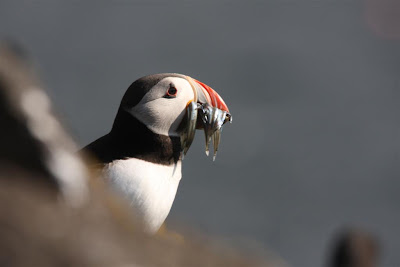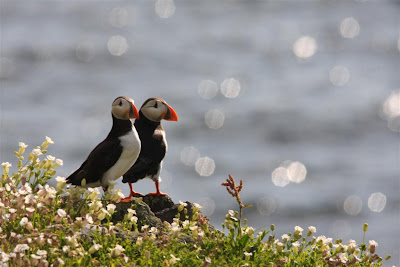 |
| Setting the nets up for fishing with puffins |
 |
| Puffin with sandeels. |
It is 5 am in the morning, close to Midsummer's day and I am standing out on the east side of the island in warm (for once), balmy conditions looking at the remains of a stunning sunrise and we're out fishing. It is the little sandeels that we are after and a small group of us are yawning and grunting but keenly watching a run of mist nets and suddenly the shout of "puffin" goes out and we sprint for the nets. We are fishing with puffins.
Seabirds are linked to the sea by their food, the fish and for many birds this means mostly sandeels. So to find out how both the birds and the fish are doing we want to measure what and how many fish the birds are bringing back in. With puffins they do the fishing and we just take them off them when they come back not the island. This means getting up early, setting up mist nets and netting them as they come back from their first fishing expedition of the day. When the puffin hits the net it drops its fish and there is a mad scramble by the island staff to 1) untangle and then ring and release the puffin and 2) more importantly gather up the fish from the ground before the gulls eat them first. Each puffin load of fish is gathered and wrapped up in foil so that at a later date the species, weight and length of the fish can be measured. For the puffins this is really only a minor convenience, they make about 5-8 fishing trips a day to get fish for their chicks but can lose many to the pirate gulls who steal them as they come back to the island. We do puffin fishing every week from mid-May to mid July but with so many puffins (90 000 +) it is extremely rare to catch the same puffin more than once in a yea and so this removal of one feed in a season doesn't have any effect on the chicks. .
Puffin fishing has been carried out by researchers on the island for over 30 years and over this length of time changes in the puffin feeding have been noticed. For a start the sandeels that puffins are catching have been getting smaller, probably because the less plankton in the seas for them to feed on, and so aren't as good at growing chicks. The overall weight of each fish load has been decreasing over time as well. To compensate for this we know at the Isle of May that puffins are bringing in more fish per load and increasing the number of loads per day but how long can they keep this up before they start to produce fewer young puffins?
In the meantime we continue to scrabble on the ground search for dropped sandeels and in between each shout of puffin admire that magnificent early morning. Until talk turn to breakfast and bacon sarnies and then it is hard to concentrate for the last few loads before we head back to the cottages, and its only its 6am.
 |
| Ringing puffins early one morning. |
 |
| A puffin in the hand usually means blood shed for the ringer. |





No comments:
Post a Comment